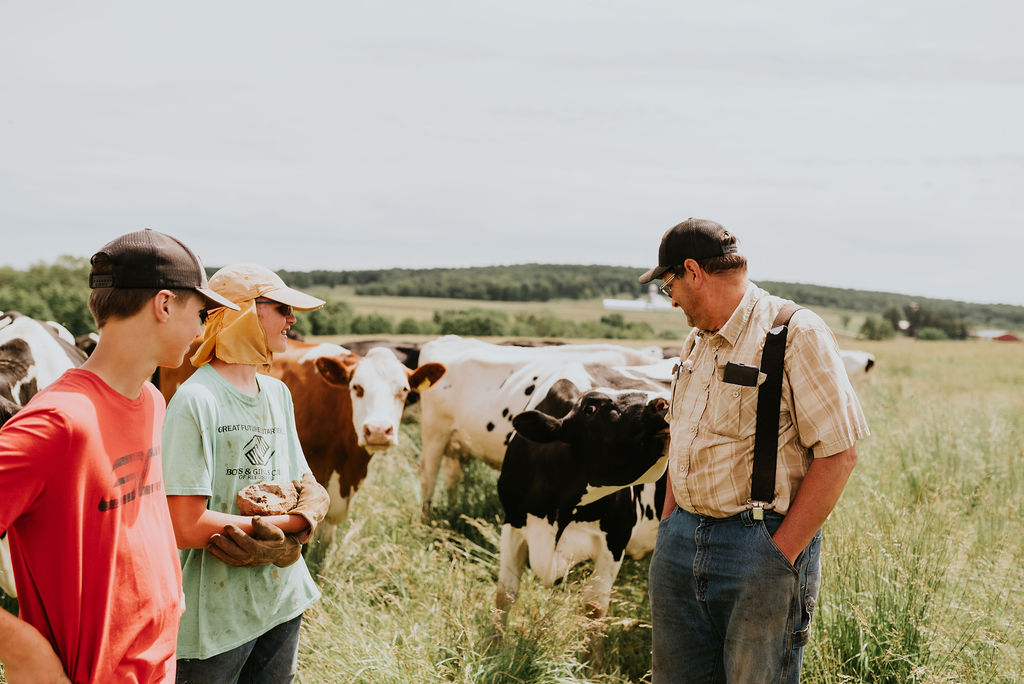Grass Legacy
This farm is on a ridge that looks out from the edge of the Baraboo Hills. The Baraboo Hills is an ecosystem comprising one of the most ancient rock outcrops in North America. Much of the region is still wooded, with durable rock called Baraboo quartzite underneath oak, maple, and basswood. The dairy is one part of a much larger farm that has been in the family for multiple generations. As this farmer retires, he’s focused on ensuring that the legacy he’s built over the years, in the form of perennial grass and all the benefits it conveys, is transferred to the next generation.

There is a lot to learn. The current farmer first tried managed rotational grazing in a contour strip in 1989. He moved to his current site in 2002 and has been rotationally grazing continuously and farming organically since then. Dairy cows are more accustomed to being around people than beef cattle, and these cows are particularly comfortable with this family as you can see in the picture above.
In managed grazing dairy farms, cows are moved to new paddocks with fresh grass as often as every 12 hours, which is possible because of moveable polywire fencing. By doing this, the cows are always eating fresh grass with peak nutritional value, and they aren’t in the paddock long enough for the grass to get trampled. By the time they make it through a series of paddocks, the grass has recovered, and they are fertilizing the paddocks as they graze. Cows can do this year-round in New Zealand. In Wisconsin, managed grazing operations have barns where they can stay warm in the winter and cool in the summer.
The process of managed grazing cattle on perennial pasture is a powerful way to restore depleted soils, keep soils intact, protecting from runoff, providing habitat for nesting birds and pollinators. The Natural Resources Conservation Service (NRCS) includes managed grazing as an approved practice in its conservation and farming programs. According to research done at the University of WI, it also produces the highest benefits of all regenerative farming practices.

This farmer has seen first-hand the benefits of organic farming and managed grazing. In 2024, his area received so much rain that there are cornfields that are completely under water. His farm has lush pastures that are producing so much grass it’s hard for the cows to keep up and it’s difficult to cut hay, but there are no flooded fields or water running off the property. When a heavy rain occurs, the road along his property will be covered with worms; he says the same road along the conventional crop farm next to his will have none.

Small family farms and the people that run them aren’t just good for the land and the cows, they are also good for their local communities. As farms consolidate and become monocropping entities, communities suffer. This farm is over 600 acres and supports multiple family members who raise beef, horses, and crops in addition to the dairy. The current dairy farmer also drives a school bus and has been on the county board. As the next generation prepares to take over, part of their preparation includes 4H trainings and events that help bring the farming community together.
As he prepares to retire from farming, this land, its perennial grass, and all the benefits that have accrued to it and the surrounding community over time, are a powerful legacy for the next generation.
For more on impact pasture-based dairy systems on animal welfare, see:
https://pubmed.ncbi.nlm.nih.gov/33865573/
J. Dairy Sci. 104:7364-7382. https://doi.org/10.3168/jds.2020-19776
For more information on the ecological benefits of managed dairy grazing:
University of Wisconsin, Grasslands 2.0, “Well managed perennial pasture: Setting the Gold Standard for Ecosystem Services, FINAL-Ecosystem Services Fact Sheet, 2022.
A note about our photos: We are excited to use photos to connect you to the farms that supply milk for your Organic Squeaks so you can learn about the wide range of eco-active practices they use. Unless noted otherwise, these photos were taken on this farm by a photographer who is also one of our farmers. We respect the culture and privacy preferences of our farm partners, which is why you won’t always see people in our photos.

